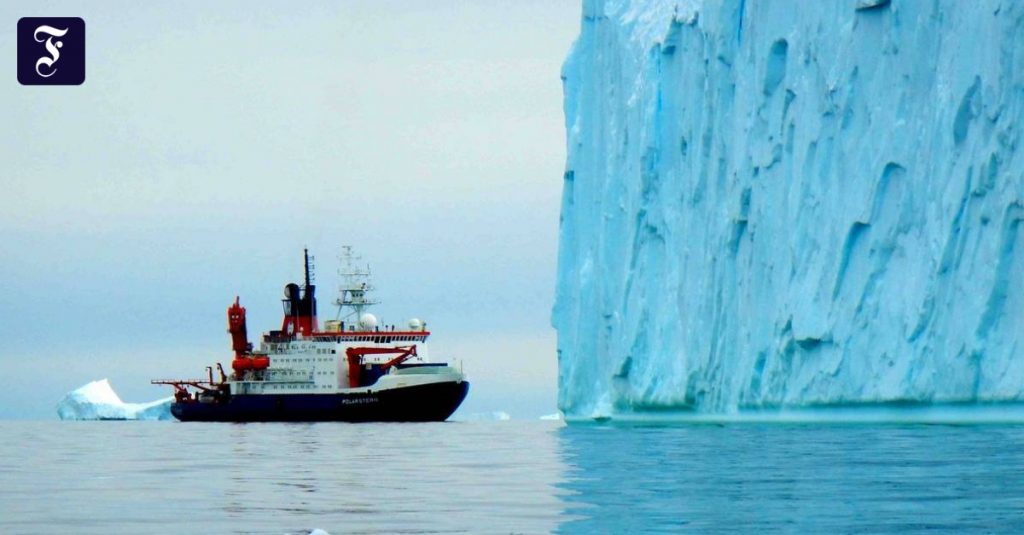NSThere is no longer any doubt that many icy Melting of “eternal” Antarctic ice and thus – as expected – contributes to the measured global rise in sea levels. The melting of ice sheets is mostly attributed to two effects of climate change, namely, rising atmospheric temperatures as well as sea water. A German-British research group has now been able to show that two of the fastest melting glaciers in Antarctica lie on a heat source, unrelated to climate change. Beneath the Thwaites and Pope glaciers in West Antarctica, the Earth’s particularly hot crust ensures that the lower ice layers are melting and the glaciers flow very rapidly into the sea as ice currents.
In contrast to the relatively stable massive ice of East Antarctica, the much smaller West Antarctic ice masses facing the Pacific Ocean are in flux. Thwaites and its neighbor, the Pope Glacier, have lost nearly 5,000 billion tons of ice there in the past 40 years. This equates to more than a third of the total ice loss on the southern continent during this period. Melt water has contributed about five percent of the world’s sea level rise.
Thin crust under the ice
East and West Antarctica differ not only in ice mass and drift rates. Geologically, the two parts of Antarctica are far apart. The huge eastern part is an ancient stable continent, called the Craton like the Canadian Shield or Siberia. On the other hand, West Antarctica is a relatively small and tectonically active region in which many earthquakes occur. There are also active volcanoes hidden under the glaciers. This is especially true of the interior along the Amundsen Sea. There, the ice one kilometer thick is located in a fault zone where the Earth’s crust is gradually disintegrating. Similar rift zones extend across large parts of East Africa, for example, but also lie under the Upper Rhine Valley between Basel and Mainz or under the upper reaches of the Rio Grande in North America.
In these rift zones, the Earth’s crust is often barely 20 kilometers thick and therefore much thinner than on ancient continents such as East Antarctica. In addition, the Earth’s crust there is fragile because the sides of the fault zone are slowly moving away from each other. Through this thin and brittle crust, geothermal heat can reach the surface from the Earth’s interior much more than in settled areas. There are several power plants in the Upper Rhine Valley, where abundant geothermal energy is used to generate electricity.
Melt water as a lubricant
The research group led by Ricarda Dziadek of the Alfred Wegener Institute in Bremerhaven has now identified geothermal flow in the West Antarctic Rift System. In their calculations, the researchers use, among other things, data from an expedition aboard the research vessel “Polarstern” in the spring of 2017. At that time, the area was mapped in detail from a helicopter for a few weeks using atmospheric magnetometers. From the magnetometry values obtained, the researchers working with Dziadek first calculated the temperatures in the Earth’s crust and then the heat flux on the Earth’s surface covered in thick ice.
Like Dziadek and her colleagues now in the electronic magazine Earth, Communication and Environment to write, The average geothermal flux in this region is about 90 milliwatts per square metre. This is consistent with values measured in other fault zones around the world. However, the heat flow under West Antarctica is by no means uniform. The research group was able to determine a very high value of 150 milliwatts per square meter under the Thwaites and Pope glaciers.
Geothermal energy is now melting the lower ice layers of these glaciers. The resulting melt water then acts as a lubricant, since the ice above can flow especially quickly towards the coast. In stable glaciers, the tongues of the glaciers float in the water, the so-called ice shelves in front of the glaciers, usually slowing this river. But as climate change erodes the ice shelves of West Antarctica’s glaciers, the braking effect is significantly reduced. Combined with increased geothermal energy, this results in a very rapid flow of the Thwaites and Pop glaciers into the sea, says AWI researcher Karsten Gohl, one of the study’s co-authors.

“Total coffee aficionado. Travel buff. Music ninja. Bacon nerd. Beeraholic.”







More Stories
Exploding Fireball: Find the meteorite fragments
Neuralink's competitor lets blind people see again with an implant
A huge meteorite has hit Earth – four times the size of Mount Everest